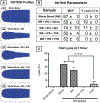Trauma-targeted delivery of tranexamic acid improves hemostasis and survival in rat liver hemorrhage model
- PMID: 31220416
- PMCID: PMC10124760
- DOI: 10.1111/jth.14552
Trauma-targeted delivery of tranexamic acid improves hemostasis and survival in rat liver hemorrhage model
Abstract
Background: Trauma-associated hemorrhage and coagulopathy remain leading causes of mortality. Such coagulopathy often leads to a hyperfibrinolytic phenotype where hemostatic clots become unstable because of upregulated tissue plasminogen activator (tPA) activity. Tranexamic acid (TXA), a synthetic inhibitor of tPA, has emerged as a promising drug to mitigate fibrinolysis. TXA is US Food and Drug Administration-approved for treating heavy menstrual and postpartum bleeding, and has shown promise in trauma treatment. However, emerging reports also implicate TXA for off-target systemic coagulopathy, thromboembolic complications, and neuropathy.
Objective: We hypothesized that targeted delivery of TXA to traumatic injury site can enable its clot-stabilizing action site-selectively, to improve hemostasis and survival while avoiding off-target effects. To test this, we used liposomes as a model delivery vehicle, decorated their surface with a fibrinogen-mimetic peptide for anchorage to active platelets within trauma-associated clots, and encapsulated TXA within them.
Methods: The TXA-loaded trauma-targeted nanovesicles (T-tNVs) were evaluated in vitro in rat blood, and then in vivo in a liver trauma model in rats. TXA-loaded control (untargeted) nanovesicles (TNVs), free TXA, or saline were studied as comparison groups.
Results: Our studies show that in vitro, the T-tNVs could resist lysis in tPA-spiked rat blood. In vivo, T-tNVs maintained systemic safety, significantly reduced blood loss and improved survival in the rat liver hemorrhage model. Postmortem evaluation of excised tissue from euthanized rats confirmed systemic safety and trauma-targeted activity of the T-tNVs.
Conclusion: Overall, the studies establish the potential of targeted TXA delivery for safe injury site-selective enhancement and stabilization of hemostatic clots to improve survival in trauma.
Keywords: fibrinolysis; hemorrhage; rat model; targeted delivery; tranexamic acid; trauma.
© 2019 International Society on Thrombosis and Haemostasis.
Conflict of interest statement
CONFLICT OF INTEREST
Sen Gupta is coauthor on issued patents US9107845 and US9107963 that are “synthetic platelet” technologies and “heteromultivalent nanoparticle composition” technologies, respectively, built on liposomal platform that are analogous in design as the nanovesicles described in the current manuscript. The patent US9107845 is licensed to Haima Therapeutics and ASG serves as a scientific consultant to this company. A. Girish, D.A. Hickman, A. Banerjee, N. Luc, Y. Ma, K. Miyazawa, U.D.S. Sekhon, and M. Sun have no conflict of interest.
Figures








Similar articles
-
Topical tranexamic acid inhibits fibrinolysis more effectively when formulated with self-propelling particles.J Thromb Haemost. 2019 Oct;17(10):1645-1654. doi: 10.1111/jth.14526. Epub 2019 Jun 26. J Thromb Haemost. 2019. PMID: 31145837
-
Effect of tranexamic acid administration on acute traumatic coagulopathy in rats with polytrauma and hemorrhage.PLoS One. 2019 Oct 3;14(10):e0223406. doi: 10.1371/journal.pone.0223406. eCollection 2019. PLoS One. 2019. PMID: 31581265 Free PMC article.
-
Hemostatic Therapy Using Tranexamic Acid and Coagulation Factor Concentrates in a Model of Traumatic Liver Injury.Anesth Analg. 2016 Jul;123(1):38-48. doi: 10.1213/ANE.0000000000001379. Anesth Analg. 2016. PMID: 27192476
-
Tranexamic acid in trauma: After 3 hours from injury, when is it safe and effective to use again?Transfusion. 2024 May;64 Suppl 2:S11-S13. doi: 10.1111/trf.17779. Epub 2024 Mar 10. Transfusion. 2024. PMID: 38461482 Review.
-
What concentration of tranexamic acid is needed to inhibit fibrinolysis? A systematic review of pharmacodynamics studies.Blood Coagul Fibrinolysis. 2019 Jan;30(1):1-10. doi: 10.1097/MBC.0000000000000789. Blood Coagul Fibrinolysis. 2019. PMID: 30585835 Free PMC article.
Cited by
-
Bioinspired artificial platelets: past, present and future.Platelets. 2022 Jan 2;33(1):35-47. doi: 10.1080/09537104.2021.1967916. Epub 2021 Aug 30. Platelets. 2022. PMID: 34455908 Free PMC article. Review.
-
New considerations on pathways involved in acute traumatic coagulopathy: the thrombin generation paradox.World J Emerg Surg. 2019 Dec 12;14:57. doi: 10.1186/s13017-019-0276-8. eCollection 2019. World J Emerg Surg. 2019. PMID: 31857822 Free PMC article.
-
Hemostatic agents for prehospital hemorrhage control: a narrative review.Mil Med Res. 2020 Mar 25;7(1):13. doi: 10.1186/s40779-020-00241-z. Mil Med Res. 2020. PMID: 32209132 Free PMC article. Review.
-
Cargo-free particles divert neutrophil-platelet aggregates to reduce thromboinflammation.Nat Commun. 2023 Apr 28;14(1):2462. doi: 10.1038/s41467-023-37990-z. Nat Commun. 2023. PMID: 37117163 Free PMC article.
-
Direct delivery of plasmin using clot-anchoring thrombin-responsive nanoparticles for targeted fibrinolytic therapy.J Thromb Haemost. 2023 Apr;21(4):983-994. doi: 10.1016/j.jtha.2022.11.037. Epub 2022 Dec 22. J Thromb Haemost. 2023. PMID: 36696210 Free PMC article.
References
-
- Cap AP, Spinella PC. Just chill – it’s worth it!. Transfusion. 2017;57:2817–20. - PubMed
-
- Cannon JW. Hemorrhagic shock. N Engl J Med. 2018;378:370–9. - PubMed
-
- Johansson PI, Stensballe J, Oliveri R, Wade CE, Ostrowski SR, Holcomb JB. How I treat patients with massive hemorrhage. Blood. 2014;124:3052–8. - PubMed
Publication types
MeSH terms
Substances
Grants and funding
LinkOut - more resources
Full Text Sources
Medical

